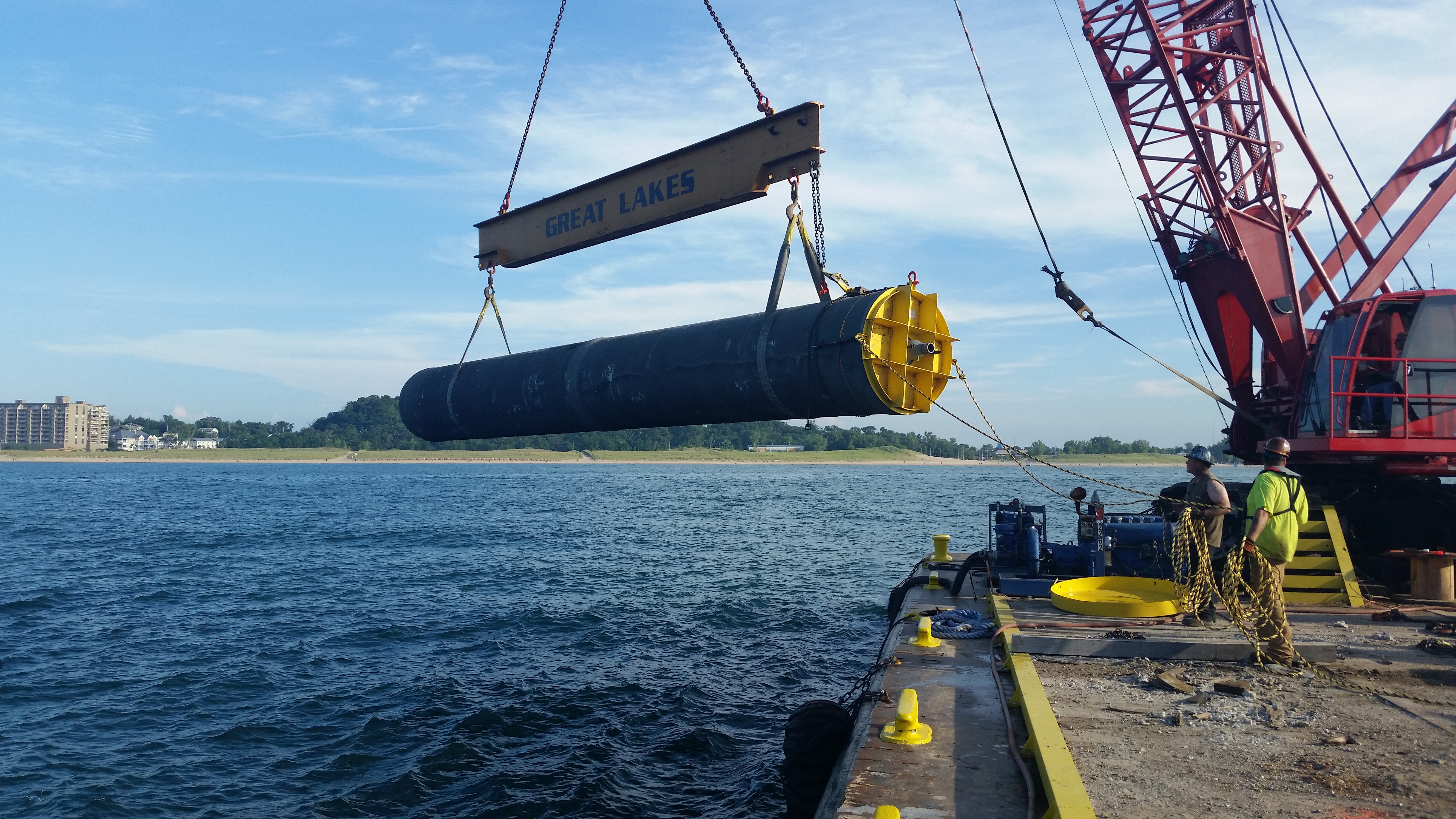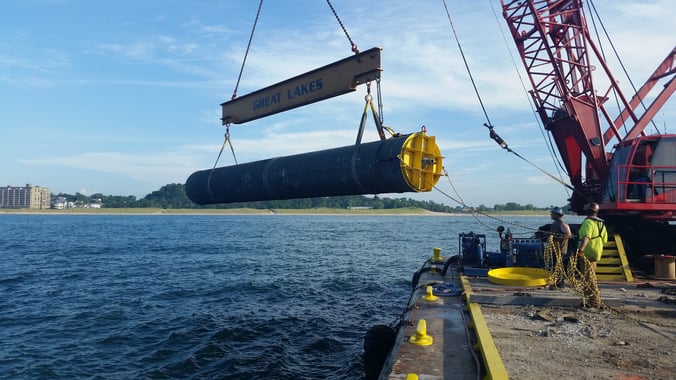Michigan City’s Department of Water Works has two raw water intakes that extend into Lake Michigan that can be used to bring water to the water treatment plant; the East Intake and the West Intake. Sands that are transported by the waves down the east shore of Lake Michigan have been accumulating in the general area of the intakes. Over several decades, the sand accumulated to the point that the intake cribs were in the surf zone. The sand began to clog the intakes, and the quality of water the Water Works could obtain was getting worse due to the turbidity of the water and the amount of sediment in the surf.
The solution to the problems was to extend the East Intake 1,500 feet farther out into Lake Michigan and install a new timber crib in the deeper water out past the surf zone. The East Intake extension was completed in 2006, and has since served as the Department’s primary intake, with the West Intake being used as a backup. An inspection in 2014 revealed the West Intake contained so much sand and sediment that it could not be used if the East Intake needed to shut down for maintenance and inspection. The Department ultimately decided that the West Intake would need to be cleaned and extended in a similar manner to the East Intake. Wessler Engineering was retained to prepare engineering documents to obtain bids for the work. After bids were received, the Department entered into a contract with Great Lakes Dock and Materials out of Muskegon, Michigan to perform the work.
The Process
Great Lakes Dock and Materials mobilized in May of 2016 to begin the intake cleaning process, using a combination of airlifting, pigging, and flushing equipment. The airlift process involved forcing air down a small pipe into a larger one down in the intake pipe. The air bubbles rising up through the larger pipe created a vacuum that was used to suck up and lift out sand and debris. The flushing was performed by pumping water from the East Intake in the common access structure on shore back into and out through the West Intake and back into the lake. The flushing operation was typically performed at night to avoid interfering with the Water Works water production operation during the day. Pigging involved using water pressure to force a semi-flexible device through the intake pipe that would push the sand and debris to the end of the pipe where it could be airlifted out. The hope was that the pig could be flushed all of the way through the intake, but a buildup of sand and debris ahead of the pig created a 175-foot long blockage that ultimately had to be removed by divers using airlifting equipment,
After cleaning the existing intake pipe, the old crib was demolished and removed. A piece of the old cast iron intake pipe had to be removed and measured so that a custom adaptor could be fabricated and used to connect the new prestressed concrete cylinder pipe before the pipe-laying process could begin. Once underway in July, the pipe laying process was a 24-hour per day operation, with two crews working 12 hours a piece, weather permitting. The day shift crew would typically dig the trench in the lakebed and lay the pipe. The night shift crew would bed the pipe with stone, backfill the trench, and help keep the excavated trench clean of the sand that was constantly being washed back into the trench by the currents. Most of the excavation and backfill work was performed with the use of the crane positioned at the front of a jack-up barge and fitted with a clamshell bucket. The further out into the lake the contractor progressed the shallower the sand became and the more clay they had to dig through, and the less sand flowed into the trench. This benefitted the crews since they did not have to dig the trench as wide and keep cleaning out the trench. Laying the intake pipe took more time than originally anticipated, but the process was completed by the end of September.
The timber intake crib, which had to be positioned on top of a funnel at the end of the intake pipe to help block large debris from flowing in, was assembled in Muskegon, Michigan on a floating work platform and towed down to Michigan City. The work platform was then partially filled with water so that it would list and the crib would slide off into the water. Ballast stone was then placed in the crib compartments to sink it as divers guided it into its final resting place. Large stones, also known as anchor rock, were then placed around the crib to ensure it could not be moved around by the strong currents that sometimes develop at the deeper depths.
The Challenges
The biggest challenge throughout the project was the weather, and, in particular, the winds. Unlike other projects, where winds are not much of a factor, the wind speed and direction on the lake determined, for the most part, when work on the lake could be performed. Winds from any direction off shore, when they picked up, could generate waves up to 10 feet high. Depending on what the wind conditions were further north up the lake, the high waves could continue for several days. Work taking place just off the shore could typically be performed when the winds were coming from on shore, because there wasn’t enough water surface for the winds to generate large waves. The winds often shifted without much notice. So what looked like a good day to work could have easily turned into a two or three-day delay.
The best part of the project was how different the marine work is when compared to on shore construction. Monitoring the construction required working 12-hour days out on a barge on Lake Michigan, sometimes seven days a week, for two or three weeks at a time. I watched multi-million dollar sailboats and yachts go by on their way to Chicago or the Michigan coast, while monitoring the contractor’s crew working a 16-hour shift, trying to get work done before the winds shifted. Contractor worked with 48” prestressed concrete cylinder pipe that, when assembled into the 40’ sections and lowered into the lake, weighed upwards of 36,000 pounds. Each section was guided into position by a diver and installed using hydraulic pressure. I watched a 29’x29’x10’ timber crib weighing tens of thousands of pounds slide off the work platform into the water and float. I relied on the divers for information about what was happening 70 feet below me in a trench on the bed of Lake Michigan. For a young engineer specializing in construction observation of water and wastewater utilities on land, monitoring the unique marine intake extension project was a challenging and rewarding experience.
Tags


